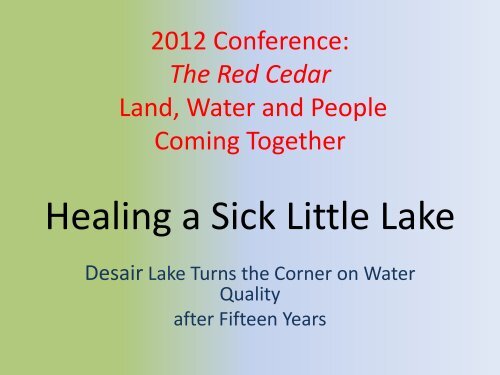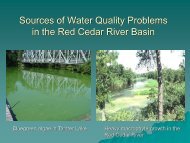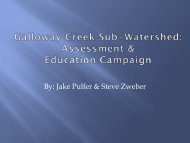Olson Desair Lake Presentation - University of Wisconsin-Extension ...
Olson Desair Lake Presentation - University of Wisconsin-Extension ...
Olson Desair Lake Presentation - University of Wisconsin-Extension ...
- No tags were found...
Create successful ePaper yourself
Turn your PDF publications into a flip-book with our unique Google optimized e-Paper software.
Where are We And where Have WeBeen?
<strong>Desair</strong> <strong>Lake</strong> facts• 74 acres in size• deepest point, 33ft• 19 residential homes on the lake• A six square mile watershed• 44% cropland• 33% woods• 17% pasture. Shrinking to near zero• 4% homes, roads and farmsteads• 2% open water and wetlands
<strong>Desair</strong> <strong>Lake</strong>’s problem:Excess Algae Growth due toPhosphorus and Nitrogen overload• Hilly terrain causes highly erodible watershed• Minimal wetlands• 120 years <strong>of</strong> dairy farming with cattle inbarnyards and pastured in the waterways• Only recent use <strong>of</strong> best management practicesby resident farmers• Cheese factory, dumped whey and otherwaste products in waterway from 1920-1970
What to Do? This Seems Hopeless!
Get On Your Boots.There’s Work to Do!
<strong>Desair</strong> <strong>Lake</strong> Restoration, Inc.formed in 1993 by 22 lake residents• DLR works to:• Monitor the water quality• Keep the shoreline natural• Avoid disturbing the lake bottom that recycles the nutrient rich silt• Minimize impact <strong>of</strong> home construction and shoreline disturbance• Aeration to prevent fish winter kill• Educate property owners and fishermen on how to reduce theirnegative impact on the lake• Encourage upland farmers to use Best Management Practices• Create educational opportunities for school children to learn lakeecology
<strong>Lake</strong> Aeration to stop fish kills
Slow No Wake and Natural Shorelines
Restore old farms, repurposedwithout cattle
1996-2000 restoration <strong>of</strong> this farm onShores <strong>of</strong> <strong>Desair</strong> <strong>Lake</strong>
Feedlot in a waterway300 feet from <strong>Lake</strong>
3 Gabion Dams toslow the water
Helping RunningWater to “Walk”
Re Vegetated Waterway
No More Sediment and Manurefrom this Waterway
Actions from 1993-2012• What has been done:• For economic reasons over the past 25 years , dairy herds on thewatershed have been reduced from 13 to 1; same number <strong>of</strong> cows butnow enclosed• All lakeshore farms have stopped operating• Marsh and stream areas, once pastured, have grown back to forest• Some highly erodible fields have been placed in CRP• Stream ravines, once used for dumps, have been closed by DLR action• Four open wells have been closed by DLR members, more are still open• DLR sponsored a “slow no wake” Township ordinance on <strong>Desair</strong> <strong>Lake</strong>• DLR supported increased lake lot sizes from 100’ to 250’ with set backsincreased from 50’ to 100’.• Three gabion dams constructed where once was a feedlot.• Two large detention ponds constructed.• DLR grant helped build over 700 feet <strong>of</strong> streambank restoration.
Severe erosion abated by streambankrestoration, 2010
<strong>Desair</strong> Creek before and afterstreambank restoration, 2010
What Happened to Our Farms?Kodesh Dairy 1976 to 2008
What’s yet to do?
Henkel Wetland Enhancementand Three Additional Detention Ponds
Alum Feasibility Study to block lakebottom phosphorus from recycling
Build Rain Garden at Public Landing
AndThere Is Still More?Continue erosion control efforts onevery square foot <strong>of</strong> watershedMonitor for exotic plants and animalsKeep all residents up to date andinvolved in lake issuesAnd there is lots <strong>of</strong> time to have funon the lake
Fishing
Track the extensive wildlife in andaround the <strong>Lake</strong>
Enjoy the loon family
“Chill” outby a campfire
What Have Our Efforts Reaped?Vast reduction <strong>of</strong> <strong>Lake</strong> sedimentexposureStabilizing <strong>of</strong> the water qualityA resident sense <strong>of</strong> pride in caringfor and not just using the <strong>Lake</strong>More efficient and productive farmsholding onto their soil
When we were kids the waterwas clean.We used the water until itturned green.Now, there’s something wecan do.To turn the water green toblue.





